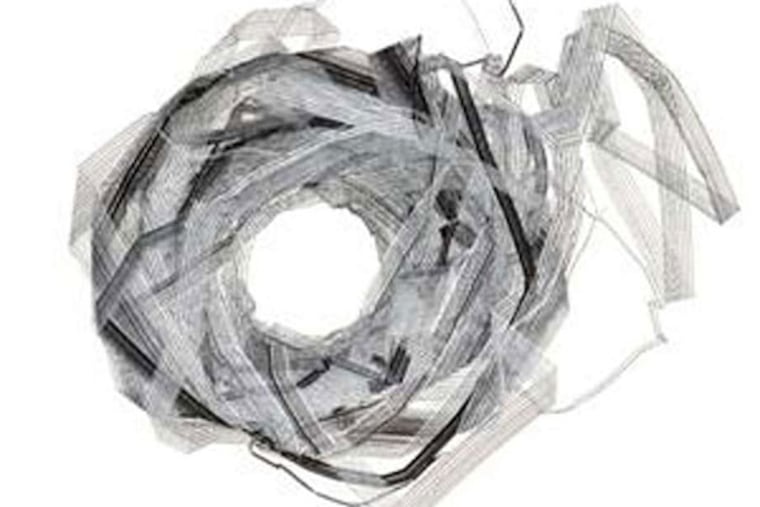Galleries: Reflecting on reflections
With its white walls, exposed beams, pale gray floors, and reflections of light filtering through the trees outside its large front windows, the second floor of the Print Center invites a calm, meditative state of mind in the midst of Center City. When the art on display there summons correspondingly quiet, introspective contemplation, the effect can be uncanny. For the most part, the sculptures and prints that make up Matt Neff's first solo show achieve this state of grace.

With its white walls, exposed beams, pale gray floors, and reflections of light filtering through the trees outside its large front windows, the second floor of the Print Center invites a calm, meditative state of mind in the midst of Center City. When the art on display there summons correspondingly quiet, introspective contemplation, the effect can be uncanny. For the most part, the sculptures and prints that make up Matt Neff's first solo show achieve this state of grace.
The title of Neff's exhibition, "Second Sight," refers to the writer and activist W.E.B. Du Bois' metaphor for the ability of black Americans to see themselves not only as they are, but as they are perceived by white Americans. Knowing this - it's revealed in the essay by Print Center director Elizabeth Spungen for the show's brochure, as are Neff's concerns about race, gender, and class (and unequal divisions of power and privilege within them) - one might naturally search for meanings in Neff's materials and techniques. Is sugar, an ingredient in several of his works, supposed to conjure the slave trade? Do his layerings and meldings of materials symbolize hidden truths?
Or you could come to this show, save the essay for later reading, and see a correlation between many of his works, particularly those with reflective surfaces, and the original definition of "second sight," the ability to see the future (and bypass the semantics, for better or worse).
Much of Neff's work refers to the printmaking process, some of it literally, as with his large wall installation, Archive Wall, 2007-14, composed of numerous prints and photographs and to which works will be added over the course of the show.
Other works refer to aspects of printmaking more abstractly, in particular the replication and serialization it affords. Several of Neff's sculptural works mounted on shelves are compositions comprising multiple layers, such as Untitled (2014), in which pieces of mirrored glass are overlapped in a horizontal format, and Prevision (2014), layers of graphite-covered paper overlapped vertically. Another untitled work involves layering from the back to the front, a wood panel so heavily encrusted with various screenprints of sugar it resembles an encaustic painting or a topographical map. Replication occurs in less obvious ways, too, as in his use of mirrored glass in the former piece and in two other works in this show, allowing multiple views of the two second-floor galleries from each of these works.
There are instances when Neff shows his influences - two wall pieces composed of folded, graphite-rubbed paper bring to mind the highly personal work of the late Philadelphia artist Bill Walton, whose posthumous show here cast a similarly poetic, somber mood - but Neff is clearly addressing very different issues.
Neff will be in residence in his own show in a project space he's called Second SITE that will serve as a studio, meeting, performance, and research venue for interaction with artists, curators, writers, and community members. Visit www.printcenter.org for information.
Terry Adkins (1953-2014), an artist, musician, and University of Pennsylvania professor, died unexpectedly of a heart attack in February shortly before his sculpture Aviarium appeared in the current Whitney Biennial (through May 25). He is remembered on the Print Center's ground floor in a show of his 2012 print portfolio, The Philadelphia Negro Reconsidered, published in collaboration with the Common Press at the University of Pennsylvania, directed by Neff. Adkins' portfolio commemorates the appointment of Du Bois as honorary emeritus professor of sociology and Africana studies in 2012 at the Penn; the exhibition honors Adkins.
Inspired by Du Bois' The Philadelphia Negro, a demographic study of Philadelphia's original Seventh Ward published in 1899, Adkins' 18 prints transform the color-coded mapping Du Bois used in his research on black urban life into modernist riffs reminiscent of Mondrian (or even Jennifer Bartlett's early baked-enamel "dot" works), but are printed on the thin paper common to such urban studies.
Paper, scissors, art
One might easily assume Jill Baroff's drawings of tide patterns - enormous circles within circles - were made directly on the paper you see before you. But her concentric circular patterns turn out to be drawn in ink on Japanese gampi paper, which she then cuts and mounts on large pieces of cotton rag paper. (Her ability to center these delicate cut pieces on such expansive sheets of rag paper in one fell swoop is frankly amazing).
Most of the drawings that make up Baroff's first solo show with Gallery Joe derive their patterns from tide charts of New York Harbor and reflect the movement of those tides. (The charts serve as the numerical basis for her concentric circles.) Newer works, among them In Walked Bud and her "riff" drawings, show Baroff arranging her cut circles into dense concentrations of lines reminiscent of crushed cans or John Chamberlain sculptures at a miniature scale. Elbe (river surge), the one drawing not based on New York Harbor's tide charts but on patterns derived from Germany's Elbe River, looks like a 45-r.p.m. record - it's also a clever nod to Duchamp's Rotoreliefs.